Physical Experiment and Numerical Simulation on Thermal Effect of Aerogel Material for Steel Ladle Insulation Layer
Abstract
:1. Introduction
2. Material and Methods
2.1. Silica Aerogel Composite Insulation Panel
2.1.1. Composition and Morphology
2.1.2. Main Performance Parameters
2.1.3. Method of Use
2.2. Surface Temperature of Outer Steel Shell
2.2.1. Numerical simulation of Temperature Field of Steel Ladle Wall
2.2.2. The Surface Temperature of Outer Steel Shell Measurement
- (1)
- Steel ladle: steel ladle during the first mid-maintenance period.
- (2)
- Steel type: SPHC (The first S is the abbreviation of Steel, P is the abbreviation of Plate, H is the abbreviation of hot Heat, and C is the abbreviation of Commercial, which generally means hot-rolled Steel Plate and Steel belt).
- (3)
- Temperature of molten steel: 1580 ± 2 °C.
- (4)
- Temperature measuring tools: infrared temperature measuring thermometer.
- (5)
- Measuring temperature time: after soft blowing at the out-station of the LF.
- (6)
- Measuring temperature position: the same position of the steel ladle.
2.3. Mathematical Model of Temperature Loss of Molten Steel
2.3.1. Heat Transfer Model
2.3.2. Related Parameters of Model
2.3.3. Verification of the Model
3. Results and Discussion
3.1. Surface Temperature of Outer Steel Shell
3.1.1. The Simulated Results
- (1).
- The temperature of the comparative ladle’s OSS was 309 °C, and the temperature at the interface OCRIP and steel shell was 417 °C. It can be calculated that the thermal resistance rate of the SACIP is 47.9%.
- (2).
- The temperature of the test ladle OSS was 242 °C, and the temperature at the interface between SACIP and steel shell was 304 °C (see Figure 8). It can be calculated that the thermal resistance rate of the SACIP is 62.0%.
3.1.2. Measuring Result
3.1.3. Simulation Result Verification
3.2. Temperature Loss of Molten Steel
3.2.1. Results of Mathematical Model Calculation
3.2.2. Measuring Result
3.3. Cost Comparison
4. Conclusions
- The actual measurement of the surface OSS temperature shows that the surface OSS average temperature of the test ladle is 59–73 °C lower than the comparison OSS. According to the simulation results of the steel ladle wall, the surface OSS temperature of the test ladle is 67 °C lower than that the comparison OSS. The simulation results are within the range of the average temperature of the actual measured surface OSS, which proves the accuracy of the FEM and the selection of related parameters.
- According to the calculation model of molten steel temperature loss, compared with the comparison ladle, the test ladle in a furnace age, can save the temperature loss of molten steel 16.67 °C, and reduce the temperature drop rate of molten steel by 0.18 °C/min. In addition, when the steel ladle furnace age is 1–100, the temperature drop rate of the test ladle can be 0.12–0.13 °C/min lower than comparison ladle. Although the difference of molten steel temperature drop rate between test ladle and comparison ladle is 0.05–0.06 °C/min lower than obtained by calculation model, the Boltzmann mathematical model is still valid in evaluating the effect of the insulation layer and relevant parameters and solutions are correct.
- In the LF, by reducing the temperature of molten steel in the test ladle by 16.67 °C, the cost of a test ladle can be reduced by CNY 5.15/ton compared with the comparison ladle. Using silica aerogel composite insulation panels on a steel ladle plays a very positive role in reducing production costs and energy consumption.
- The new method designed in this paper to calculate the thermal insulation effect of steel ladle insulation layers is feasible. The ladle wall temperature is obtained by finite element model and experiment, then the heat emission from the ladle wall is calculated by the Boltzmann equation according to ladle wall temperature, and the temperature loss of molten steel is calculated inversely according to the heat emission.
- In a furnace age, the surface temperature of OSS of the test ladle measured fluctuated by a larger amount than did the comparison ladle. The specific reason for this is still unclear, and further study is required.
Author Contributions
Funding
Institutional Review Board Statement
Informed Consent Statement
Data Availability Statement
Conflicts of Interest
Nomenclature
| Abbreviation | Description | Unit |
| CP | Special heat capacity | J/kgk |
| T | Temperature | °C |
| t | Time | s |
| r | Ladle wall radius | m |
| z | Ladle wall thickness | m |
| k | Thermal conductivity | W/mK |
| h | convective heat transfer coefficient | W/m2K |
| A | Area | m2 |
| Nu | Nusselt Number | dimensionless |
| D | Diameter | m |
| H | Height | m |
| Gr | Grashof Number | dimensionless |
| Pr | Prandtl Number | dimensionless |
| C | Constant determined by experiment | dimensionless |
| n | Constant determined by experiment | dimensionless |
| g | Gravitational acceleration | m/s2 |
| Heat | J | |
| m | Quality | kg |
| Greek Symbols | ||
| ρ | Density | kg/m3 |
| λ | Thermal conductivity | W/mK |
| φ | Heat flow | W |
| ε | Emissivity | dimensionless |
| σ | Boltzmann constant | W/m2 K4 |
| α | Volume expansion coefficient | dimensionless |
| ν | Kinematic viscosity | m2/s |
Appendix A. Mathematical Model Calculation Process of Temperature Loss of Molten Steel
| Steel Ladle Condition | Surface Temperature of OSS (+273 K) | ||
|---|---|---|---|
| Measurement Result | Simulation Result | ||
| Early Stage (1–50 Furnace Age) | Later Stage (51–100 Furnace Age) | ||
| Test ladle | 233 | 260 | 242 |
| Comparison ladle | 306 | 319 | 309 |
| Parameter | Value |
|---|---|
| φ | 0.717 × 106 W |
| m | 1.30 × 105 kg |
| t | 5400 s |
| CP (1600 °C) | 0.837 × 103 J/kg°C |
References
- Glaser, M.; Gornerup, M.; Du, S.C. Fluid flow and heat transfer in the ladle during teeming. Steel Res. Int. 2011, 82, 827–835. [Google Scholar] [CrossRef]
- Wang, Y.; Ai, X.G.; Liu, F.; Zhong, W.M.; Huang, R.H. Physical simulation of symmetric alternating bottom blowing mixing behavior in double orifice ladle. China Metall. 2017, 27, 18–21. [Google Scholar]
- Glaser, B.; GorRnerup, M.; Du, S.C. Thermal modelling of the ladle preheating process. Steel Res. Int. 2011, 82, 1425–1434. [Google Scholar] [CrossRef]
- Wang, S.S.; Guo, X.C.; Jiang, W.H.; Li, Q.; Zhang, F. Numerical simulation and field practice of flow field in 100 t bottom blown argon ladle. China Metall. 2018, 28, 51–55. [Google Scholar]
- Liu, Z.Z.; Guo, H.Z. Development and present situation concering heat transfer research of ladle. Iron Steel Res. 2007, 2, 59–63. [Google Scholar]
- Dong, P.L. Physical simulation of 210 t ladle bottom blowing process optimization. Iron Steel 2016, 51, 41–45. [Google Scholar]
- Zhang, Y.Y.; Cui, K.K.; Fu, T.; Wang, J.; Shen, F.Q.; Zhang, X.; Yu, L.H. Formation of MoSi2 and Si/MoSi2 coatings on TZM (Mo-0.5Ti-0.1Zr-0.02C) alloy by hot dip silicon-plating method. Ceram. Int. 2021, 47, 23053–23065. [Google Scholar] [CrossRef]
- Wohrmeyer, C.; Gao, S.M.; Ping, Z.F.; Parr, C. Corrosion mechanism of MgO-CMA-C ladle brick with high service life. Steel Res. Int. 2019, 91, 1900436. [Google Scholar] [CrossRef]
- Chang, W.J. Influence Analysis and Life Prediction of New Structure Ladle with Super-Insulation and Lightweight. Master’s Thesis, Wuhan University of Science and Technology, Wuhan, China, 1 June 2018. [Google Scholar]
- He, W.X. Development on Longevity and High Efficient Thermal Insulation Technique of Ladle with Thin Layer and Its Application. Master’s Thesis, Chongqing University, Chongqing, China, 1 June 2007. [Google Scholar]
- Onyeaju, M.C.; Osarolube, E.; Chukwuocha, E.O.; Ekuma, C.E.; Omasheye, G. Comparison of the thermal properties of asbestos and polyvinylchloride (PVC) ceiling sheets. Mater. Sci. Appl. 2012, 3, 240–244. [Google Scholar] [CrossRef] [Green Version]
- Khalaf, F.M. Using crushed clay brick as coarse aggregate in concrete. J. Mater. Civ. Eng. 2006, 18, 518–526. [Google Scholar] [CrossRef]
- Hall, C.; Wilson, M.A.; Hoff, W.D. Kinetics of long-term moisture expansion in fired-clay brick. J. Am. Ceram. Soc. 2011, 94, 3651–3654. [Google Scholar] [CrossRef]
- Zhang, Y.Y.; Fu, T.; Cui, K.K.; Shen, F.Q.; Wang, J.; Yu, L.H.; Mao, H.B. Evolution of surface morphology, roughness and texture of tungsten disilicide coatings on tungsten substrate. Vacuum 2021, 191, 110297. [Google Scholar] [CrossRef]
- Cui, K.; Zhang, Y.; Fu, T.; Hussain, S.; Saad Algarni, T.; Wang, J.; Zhang, X.; Ali, S. Effects of Cr2O3 content on microstructure and mechanical properties of Al2O3 matrix composites. Coatings 2021, 11, 234. [Google Scholar] [CrossRef]
- Gruber, D.; Harmuth, H. Thermomechanical behavior of steel ladle linings and the influence of insulations. Steel Res. Int. 2014, 84, 512–518. [Google Scholar] [CrossRef]
- Jia, C.J.; Song, D.J.; Sun, J.B. Research on the application of new type thermal insulation material for casting ladle. Foundry Equip. Technol. 2018, 1, 42–44. [Google Scholar]
- Sun, Y.; Zhao, S.H.; Li, Z.S. Development of aerogel insulation board and its thermal insulation effect in ladle. Tianjin Sci. Technol. 2018, 8, 59–61. [Google Scholar]
- Lv, W.; Mao, Z.; Yuan, P.; Jia, M. Pruned bagging aggregated hybrid prediction models for forecasting the steel temperature in ladle furnace. Steel Res. Int. 2014, 85, 405–414. [Google Scholar] [CrossRef]
- Romao, I.; Nduagu, E.; Fagerlund, J.; Gando-Ferreira, L.M.; Zevenhoven, R. CO2 fixation using magnesium silicate minerals. Part 2: Energy efficiency and integration with iron-and steelmaking. Energy 2012, 41, 203–211. [Google Scholar] [CrossRef]
- Taddeo, L.; Gascoin, N.; Fedioun, I.; Chetehouna, K.; Lamoot, L.; Fau, G. Dimensioning of automated regenerative cooling: Setting of high-end experiment. Aerospace Sci. Tech. 2015, 43, 350–359. [Google Scholar] [CrossRef]
- Cui, Z.; Zhang, J.; Wu, D. Hybrid many-objective particle swarm optimization algorithm for green coal production problem. Inf. Sci. 2020, 518, 256–271. [Google Scholar] [CrossRef]
- Hu, J.; Sun, Y.; Li, G.; Jiang, G.; Tao, B. Probability analysis for grasp planning facing the field of medical robotics. Measurement 2019, 141, 227–234. [Google Scholar] [CrossRef]
- Wu, X.H.; Meng, X.W.; Chen, L.; Zheng, C.L. Numerical simulation of ladle temperature field under the working conditions of ladle baking and steel holding. Electron. Qual. 2018, 376, 84–86. [Google Scholar]
- Li, H.C.; Huang, S.M.; Chen, X.Y. Simulation research of ladle temperature field and stress field based on ANSYS. Equip. Manuf. Technol. 2007, 40, 35–37. [Google Scholar]
- Warzecha, M.; Jowsa, J.; Warzecha, P.; Pfeifer, H. Numerical and experimental investigations of steel mixing time in a 130 t ladle. Steel Res. Int. 2008, 79, 852–857. [Google Scholar] [CrossRef]
- Chen, Y.C.; Bao, Y.; Wang, M.; Zhao, L.; Peng, Z. A mathematical model for the dynamic desulfurization process of ultra-low-sulfur steel in the LF refining process. Metall. Res. Technol. 2014, 111, 37–43. [Google Scholar] [CrossRef]
- Wu, Y.F.; He, D.F.; Xu, A.J.; Tian, N.Y. Numerical simulation and optimization of temperature field in the baking ladle. J. Iron Steel Res. 2012, 21, 21–24. [Google Scholar]
- Li, Q. Study on Heat Transfer Model of Ladle in Steelmaking and Continuous Casting Process. Master’s Thesis, Northeastern University, Shenyang, China, 7 July 2010. [Google Scholar]
- Wu, T.; Chen, M.; Zhang, L.; Xu, X.; Liu, Y.; Yan, J.; Wang, W.; Gao, J. Three-dimensional graphene-based aerogels prepared by a self-assembly process and its excellent catalytic and absorbing performance. J. Mater. Chem. A 2013, 1, 7612–7621. [Google Scholar] [CrossRef]
- Li, D.Y. Physical and mathematical model of heat transfer in plasma ladle furnace. Iron Steel 1997, 3, 16–18. [Google Scholar]
- Li, Q.; Wei, D.Y.; Yang, C. Calculation and analysis of steady-state heat transfer of 150-Ton ladle wall. Metall. Ser. 2015, 1, 8–11. [Google Scholar]
- Solorio-Diaz, G.; Davila-Morales, R.; Jose, B.S.; Vergara-Hernández, H.J.; Ramos-Banderas, A.; Galvan, S.R. Numerical modelling of dissipation phenomena in a new ladle shroud for fluidynamic control and its effect on inclusions removal in a slab tundish. Steel Res. Int. 2014, 85, 863–874. [Google Scholar] [CrossRef]
- Zhou, Y.; Dong, Y.C.; Wang, H.C.; Wang, S.J.; Liu, Y.B. Mathematical simulation of flow phenomena in CAS-OB refining ladle. J. Iron Steel Res. 2003, 10, 8–12. [Google Scholar]
- Singham, J.R. Tables of emissivity of surfaces. Int. J. Heat Mass Transf. 1962, 5, 67–76. [Google Scholar] [CrossRef]
- Luo, B.; Li, G.; Kong, J.; Jiang, G.; Sun, Y.; Liu, Z.; Chang, W.; Liu, H. Simulation analysis of temperature field and its influence factors of the new structure ladle. Appl. Math. Inf. Sci. 2017, 11, 589–599. [Google Scholar] [CrossRef]
- Farrera-Buenrostro, J.E.; Hernández-Bocanegra, C.A.; Ramos-Banderas, J.A.; Torres-Alonso, E.; López-Granados, N.M.; Ramírez-Argáez, M.A. Analysis of temperature losses of the liquid steel in a ladle furnace during desulfurization stage. Trans. Indian Inst. Met. 2019, 11, 22–23. [Google Scholar] [CrossRef]
- Lu, B.; Meng, X.; Zhu, M. Numerical analysis for the heat transfer behavior of steel ladle as the thermoelectric waste-heat source—ScienceDirect. Catal. Today 2018, 318, 180–190. [Google Scholar] [CrossRef]
- Prabhakaran, S.; Maboob, S.A. Numerical analysis and experimental investigation on behavior of cold-formed steel castellated beam with diamond castellation. Int. J. Steel Struct. 2021, 21, 1082–1091. [Google Scholar] [CrossRef]
- Xia, J.L.; Ahokainen, T. Transient flow and heat transfer in a steelmaking ladle during the holding period. Met. Mater. Trans. B 2001, 32, 733–741. [Google Scholar] [CrossRef]
- Urióstegui-Hernández, A.; Garnica-González, P.; Ángel Ramos-Banderas, J.; Hernández-Bocanegra, C.A.; Solorio-Díaz, G. Multiphasic study of fluid-dynamics and the thermal behavior of a steel ladle during bottom gas injection using the eulerian model. Metals 2021, 11, 1082. [Google Scholar] [CrossRef]
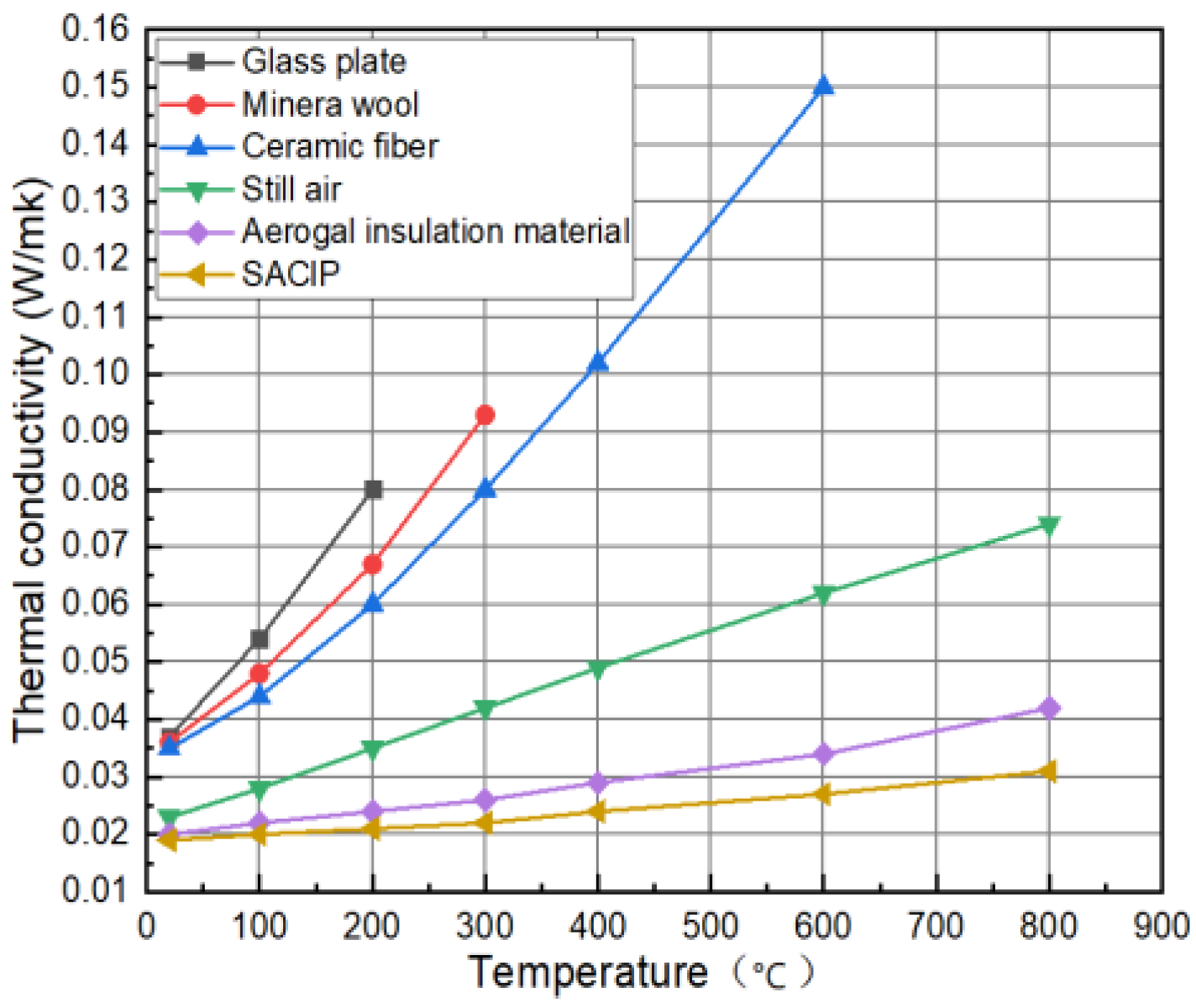

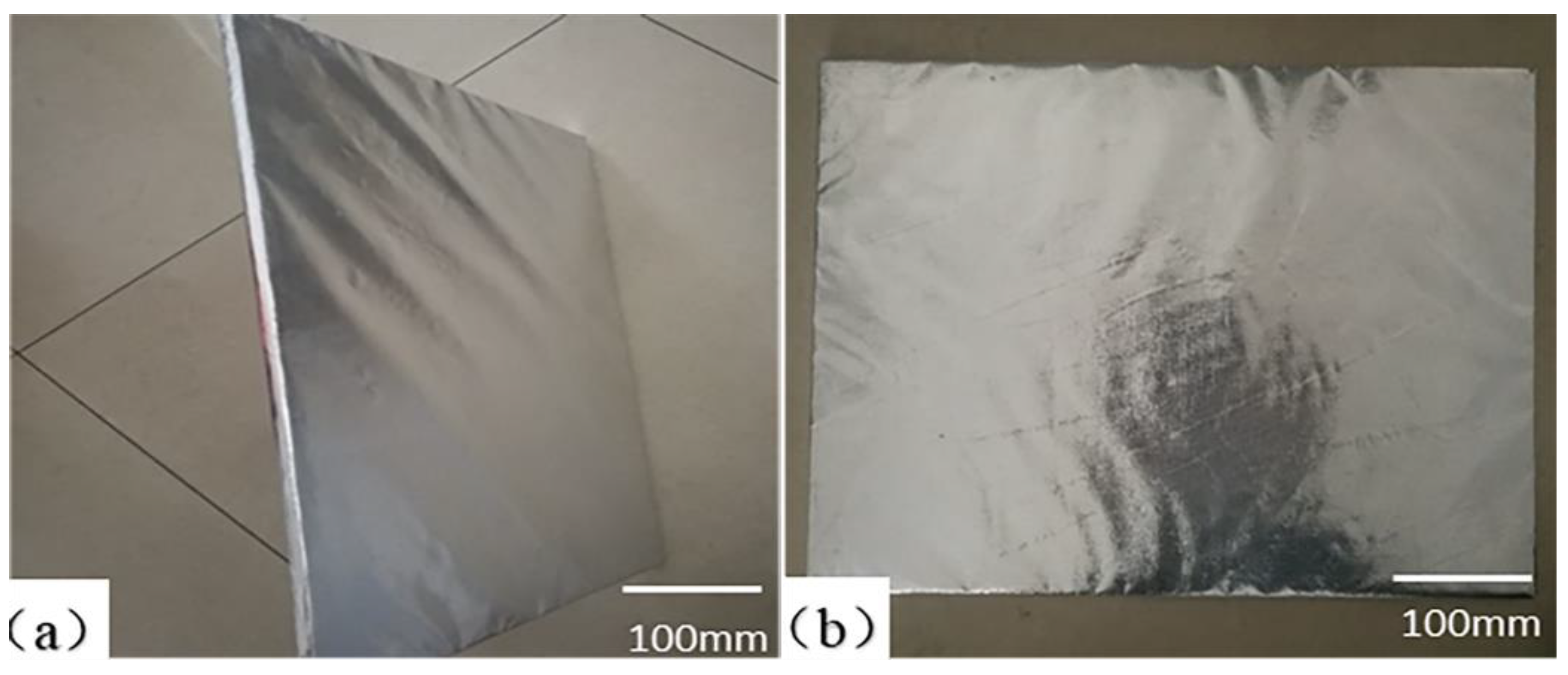
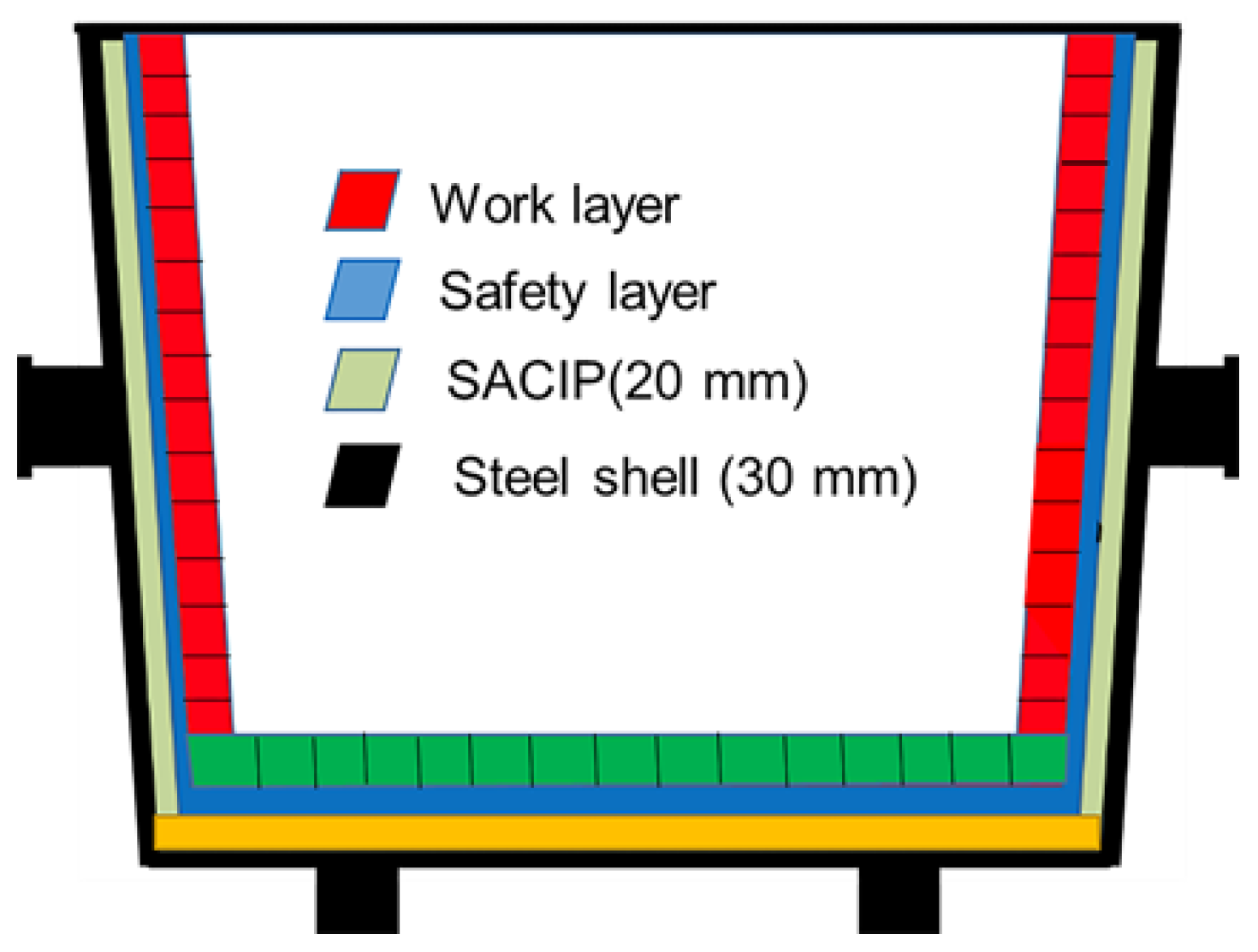
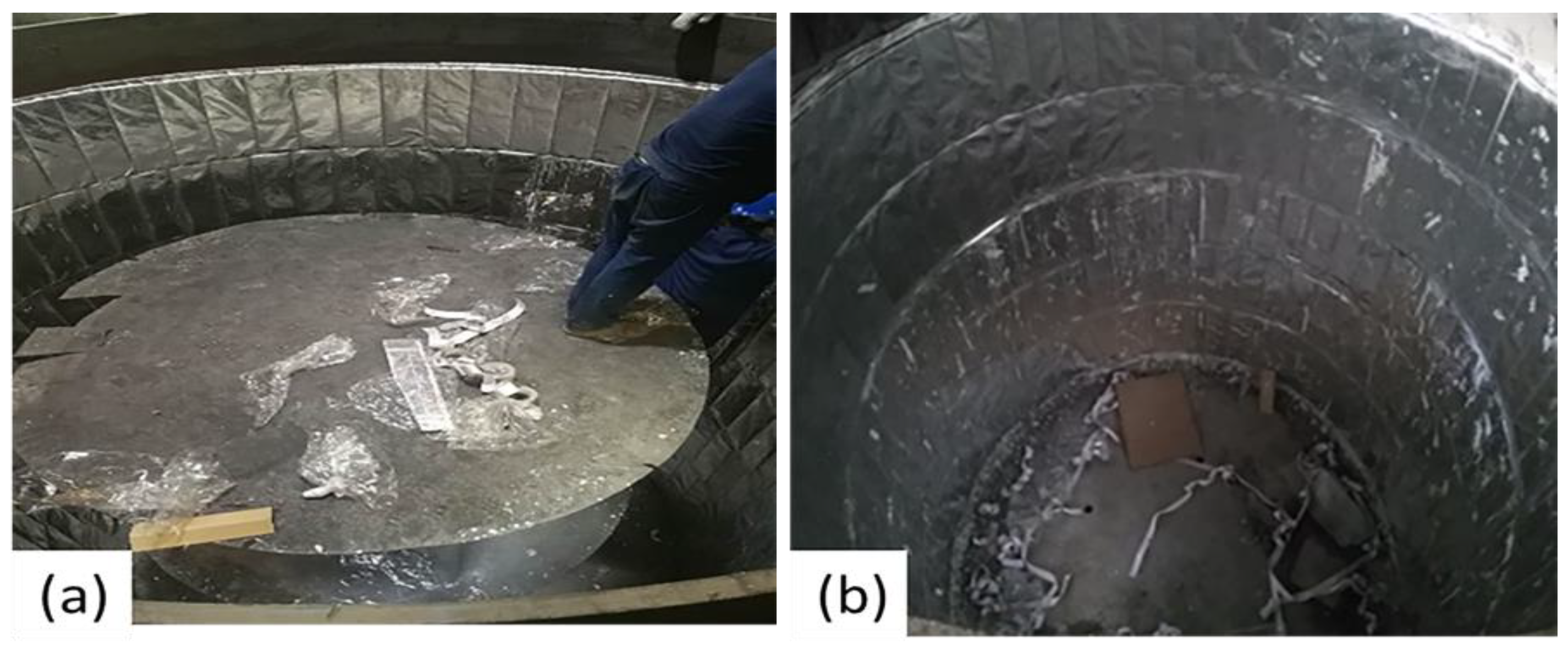
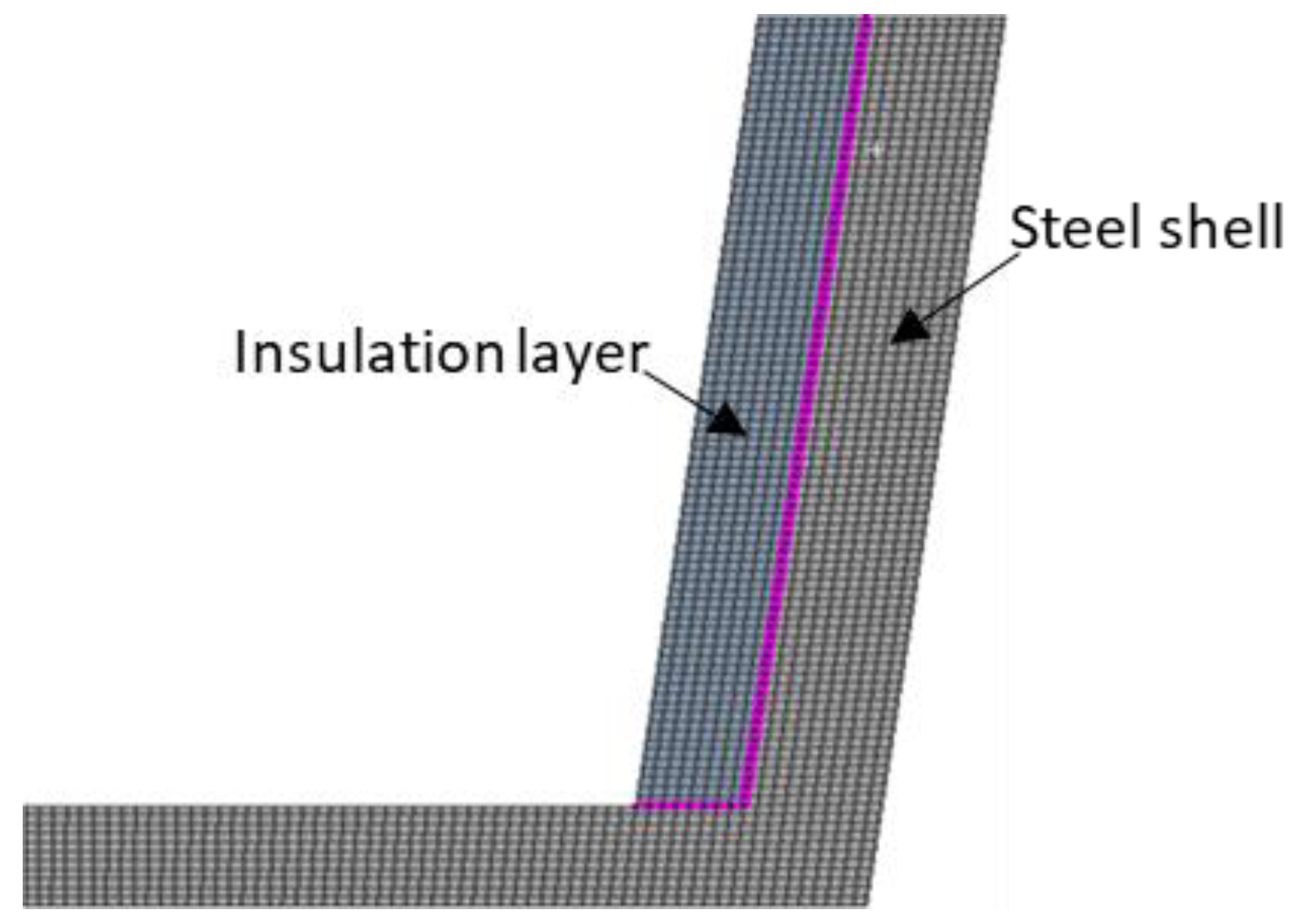

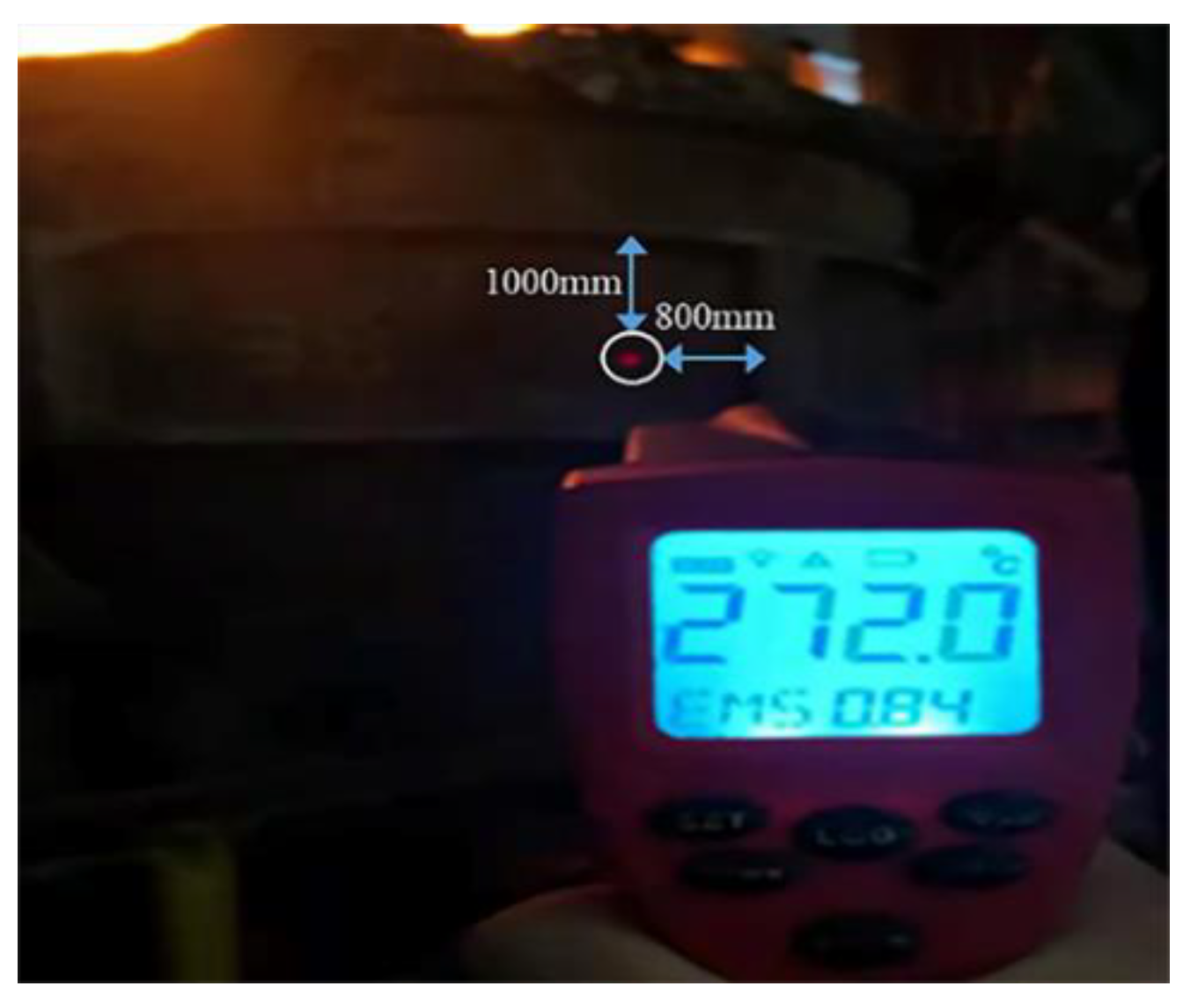
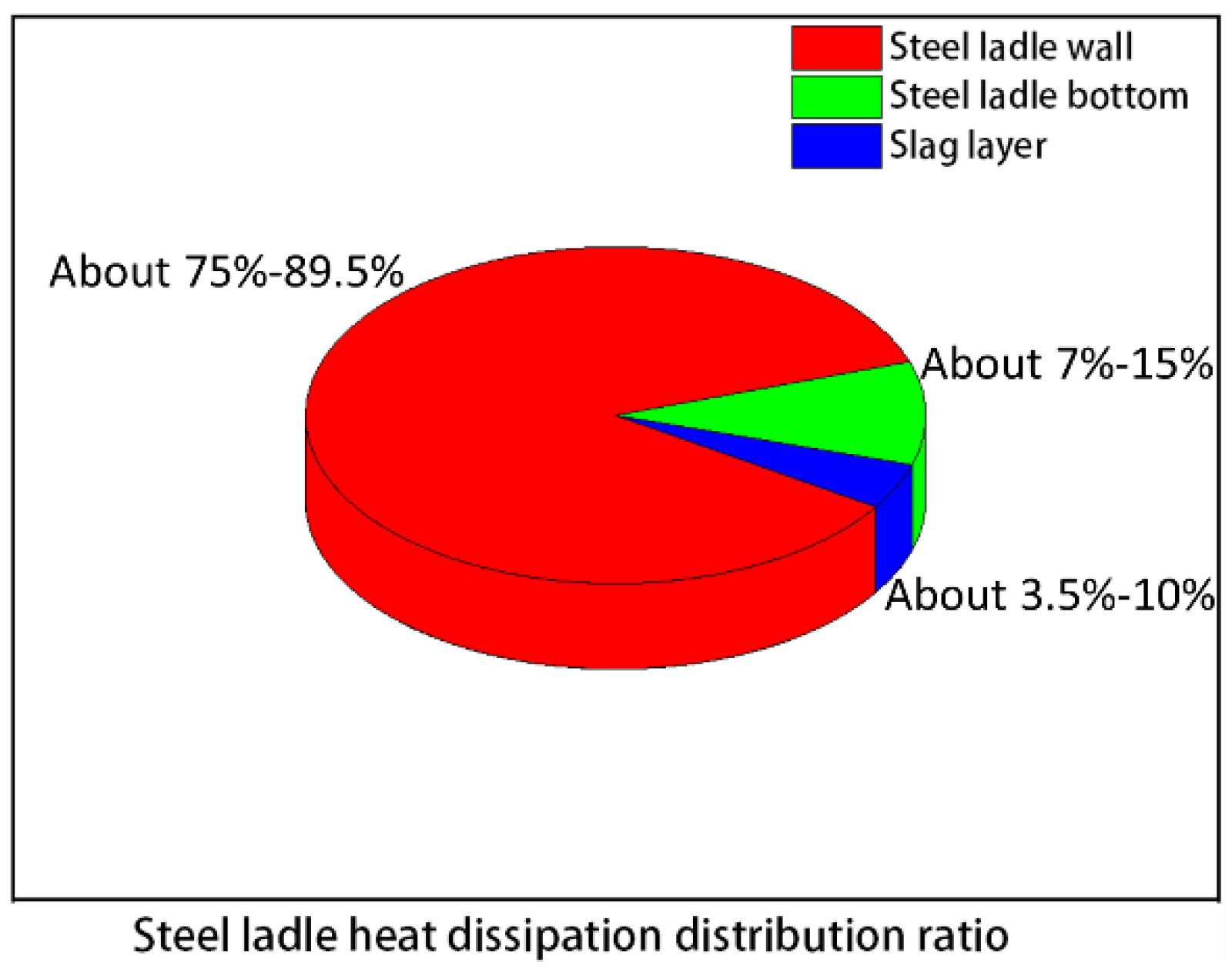
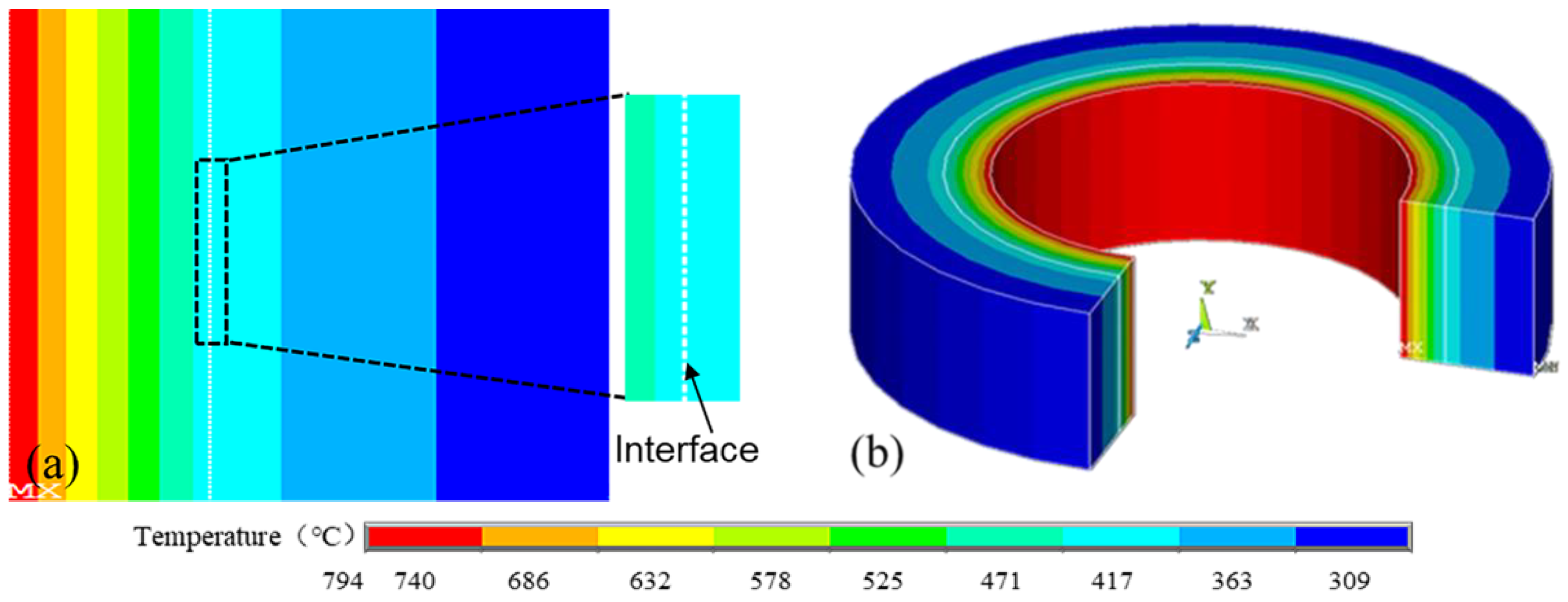


| Material | Physical Parameters | ||
|---|---|---|---|
| Density (kg/m3) | Refractoriness (°C) | Thermal Conductivity (W/mK) {Hot Surface Temperature: 800 (°C)} | |
| OCRIP | 536 | 1560 | 0.073 |
| SACIP | 149 | 1760 | 0.031 |
| Parameters | Value |
|---|---|
| DLadle | 3.56 m |
| H | 4.0 m |
| π | Constant |
| Temperature | Thermal Conductivity | Kinematic Viscosity | Prandtl Number |
|---|---|---|---|
| Tqualitative temperature (+273 K) | λ (×10−2 W/mK) | v (×10−6 m2/s) | Pr |
| 130 | 3.42 | 26.63 | 0.6850 |
| 135 | 3.45 | 27.21 | 0.6846 |
| 140 | 3.49 | 27.80 | 0.6840 |
| 145 | 3.53 | 28.38 | 0.6834 |
| 150 | 3.57 | 28.95 | 0.6830 |
| 155 | 3.60 | 29.56 | 0.6824 |
| 160 | 3.64 | 30.09 | 0.6820 |
| 165 | 3.67 | 30.66 | 0.6817 |
| 170 | 3.71 | 31.31 | 0.6815 |
| 175 | 3.74 | 31.96 | 0.6810 |
| Rayleigh Number (the Product of GrPr) | C | n |
|---|---|---|
| 1 × 10−3–5 × 102 | 1.18 | 1/8 |
| 5 × 102–2 × 107 | 0.54 | 1/4 |
| 2 × 107–1 × 1013 | 0.135 | 1/3 |
| Items | Temperature (°C) | Thermal Resistance | |
|---|---|---|---|
| OSS | Interface | ||
| Comparison ladle wall | 309 | 417 | 47.9% |
| Test ladle wall | 242 | 304 | 62.0% |
| Difference value (the comparison ladle wall minus the test ladle wall) | 67 | 113 | 14.1% |
| Steel Ladle Condition | Surface Temperature of OSS (°C) | ||
|---|---|---|---|
| Measurement Result (Average Value) | Simulation Result | ||
| Early Stage (1–50 Furnace Age) | Later Stage (51–100 Furnace Age) | ||
| Test ladle | 233 | 260 | 242 |
| Comparison ladle | 306 | 319 | 309 |
| Parameter | Value |
|---|---|
| φ | 0.717 × 106 W |
| m | 1.30 × 105 kg |
| t | 5400 s |
| CP (1600 °C) | 0.837 × 103 J/kg °C |
| Steel Ladle Condition | A (a) (Furnace Age) | N (b) (Furnace) | T (c) (°C) | T (d) (°C) | T (e) (min) | V (f) (°C/min) |
|---|---|---|---|---|---|---|
| Comparison ladle | Early stage (1–50) | 24 | 1585.4 | 1577.1 | 15.4 | 0.54 |
| Test ladle | 23 | 1583.1 | 1576.6 | 15.7 | 0.41 | |
| Comparison ladle | later stage (51–100) | 18 | 1584.9 | 1577.2 | 14.8 | 0.52 |
| Test ladle | 20 | 1585.2 | 1579.2 | 15.1 | 0.40 |
| Each Ton of Molten Steel Rises by 1 °C | Reference Electricity Price (CNY/kwh) | Reference Electrode Price (CNY/kg) | |
|---|---|---|---|
| Electricity Consumption (°C/kwh) | Electrode Consumption (kg/ton) | ||
| 0.69 | 0.0034 | 0.475 | 9.72 |
Publisher’s Note: MDPI stays neutral with regard to jurisdictional claims in published maps and institutional affiliations. |
© 2021 by the authors. Licensee MDPI, Basel, Switzerland. This article is an open access article distributed under the terms and conditions of the Creative Commons Attribution (CC BY) license (https://creativecommons.org/licenses/by/4.0/).
Share and Cite
Zhang, L.; Zhu, L.; Zhang, C.; Wang, Z.; Xiao, P.; Liu, Z. Physical Experiment and Numerical Simulation on Thermal Effect of Aerogel Material for Steel Ladle Insulation Layer. Coatings 2021, 11, 1205. https://doi.org/10.3390/coatings11101205
Zhang L, Zhu L, Zhang C, Wang Z, Xiao P, Liu Z. Physical Experiment and Numerical Simulation on Thermal Effect of Aerogel Material for Steel Ladle Insulation Layer. Coatings. 2021; 11(10):1205. https://doi.org/10.3390/coatings11101205
Chicago/Turabian StyleZhang, Limin, Liguang Zhu, Caijun Zhang, Zhiqiang Wang, Pengcheng Xiao, and Zenxun Liu. 2021. "Physical Experiment and Numerical Simulation on Thermal Effect of Aerogel Material for Steel Ladle Insulation Layer" Coatings 11, no. 10: 1205. https://doi.org/10.3390/coatings11101205




